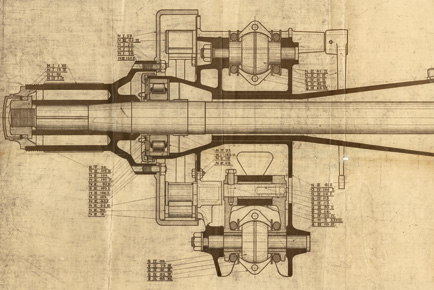Articles
Kings of the road: An early Lanchester vehicle being tested
Frederick Lanchester was one of the earliest innovators to recognise the potential of the Otto four-stroke engine in the 1890s for a nation driven by vast industrial ambition.
Work on the first Lanchester car began in 1895 before it was road tested the following year. Three years later the Lanchester Engine Company was incorporated.
Its first automobile was significantly, and unusually, designed from first principles as a car and not as a horseless carriage with a single-cylinder 1,306cc engine, a piston with two connecting rods to separate the crankshafts, and flywheels rotating in opposite directions, for smoother running.
Demonstrators were then built with two-cylinder, 4,033cc horizontal air-cooled engines. Steering was by side lever rather than by a wheel.
These first models were sold to the public in 1901. In the Proceedings of the Institution of Mechanical Engineers (June 1937), Lanchester describes his technical achievements, and subsequent developments, with a selection of detailed illustrations.
Despite a full order book, the company ran out of money in 1904. Following a period in receivership, the business was reorganised, re-capitalised and incorporated as the Lanchester Motor Company.
The automobile industry was still in its infancy and in a precarious position with long lead times and orders that very often were not fulfilled quickly enough for payments to come in at regular intervals.
The 1904 models had 2,470cc, four-cylinder engines featuring pressure lubrication – very unusual at the time – and were mounted with the epicyclic gearbox between the front seats rather than centrally. The design meant the driver sat well forward and the car had no bonnet.From 1911, the specification started to become more recognisable, with wheel steering as standard, pedals and a gear lever replacing the original two-lever gear system. Up until this point driving was a very physical pursuit, requiring the pulling of three levers at precise times.
 Fine detail: Lanchester drawings can be found in the IMechE archive
Fine detail: Lanchester drawings can be found in the IMechE archive
The engine then moved further forward to a conventional position in the sporting, side-valve, 5.5-litre six-cylinder Lanchester Forty but very few were made before the outbreak of World War One.
Car production continued throughout World War One, albeit to a lesser degree as manufacturers focused on munitions. Part of Lanchester's contribution to the war effort was the 4x2 armoured car used on the Western Front.
From 1918 the company reintroduced the Forty with a 6.2-litre overhead-cam engine and a three-speed gearbox.
It was very expensive – costing more than a Rolls-Royce Silver Ghost – and the company's only manufactured model until a smaller car, the Twenty One, came along in 1924 to sustain production.
The Twenty One had a 3.1-litre, six-cylinder engine, removable cylinder head mated to a four-speed conventional gearbox and four-wheel brakes.
The Forty was then replaced in 1928 by the Thirty, which had a straight-eight 4.4-litre engine.
In 1928 Frederick Lanchester’s brother George, who had managed the company for 15 years, developed a 4,446cc straight-eight version but only 126 were ever made.
The Wall Street Crash killed demand and by 1930 the company was again in desperate financial straits with an overdraft of £38,000 which forced its sale to BSA.
Car production was transferred to Lanchester’s new sister subsidiary, Daimler, with George kept on as a senior designer to maintain the Lanchester link.